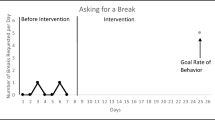Abstract
An overriding goal for all children on the autism spectrum is for them to function independently in their completion of daily routine skills, such as getting dressed, eating, and using the toilet. Unfortunately, most published curricula and teaching guidelines have focused on communication and academic skills rather than on self-help skills. The book, Self-help skills for people with autism: A systematic teaching approach, by Anderson and colleagues, provides parents and professionals with a systematic method for planning and teaching these valuable skills using scientifically proven methods of applied behavior analysis (ABA). This book is reviewed in terms of the strengths and limitations of the content, as well as its importance as a practical educational tool for assisting those who train individuals with autism.
Similar content being viewed by others
References
Anderson, S. R., Jablonski, A. L., Thomeer, M. L., & Madaus Knapp, V. (2007). Self-help skills for people with autism: A systematic teaching approach. Bethesda, MD: Woodbine House, Inc.
Baker, B. L., & Brightman, A. J. (2004). Steps to independence: Teaching everyday skills to children with special needs. Baltimore, MD: Paul H. Brookes Publishing.
Cicero, F. R., & Pfadt, A. (2002). Investigation of a reinforcement-based toilet training procedure for children with autism. Research in Developmental Disabilities, 23, 319–331.
Cohen, H., Amerine-Dickens, M., & Smith, T. (2006). Early intensive behavioral treatment: Replication of the UCLA model in a community setting. Journal of Developmental & Behavioral Pediatrics, 27, 145–155.
Eikeseth, S., Smith, T., & Eldevik, E. S. (2002). Intensive behavioral treatment at school for 4- to 7-year old children with autism. Behavior Modification, 26, 49–68.
Foxx, R. M., & Azrin, N. H. (1973). Toilet training persons with developmental disabilities. Harrisburg, PA: Help Services Press.
Lovaas, O. I. (1987). Behavioral treatment and normal educational and intellectual functioning in young autistic children. Journal of Consulting and Clinical Psychology, 55, 3–9.
McEachin, J. J., Smith, T., & Lovaas, O. I. (1993). Long-term outcome for children with autism who received early intensive behavioral treatment. American Journal on Mental Retardation, 97, 359–372.
Sallows, G. O., & Graupner, T. D. (2005). Intensive behavioral treatment for children with autism: Four-year outcome and predictors. American Journal on Mental Retardation, 110, 417–438.
Author information
Authors and Affiliations
Rights and permissions
About this article
Cite this article
Lucker, K.D. A Review of Self-Help Skills for People with Autism: A Systematic Teaching Approach by Stephen R. Anderson, Amy L. Jablonski, Marcus L. Thomeer, and Vicki Madaus Knapp. Behav Analysis Practice 2, 65–67 (2009). https://doi.org/10.1007/BF03391740
Published:
Issue Date:
DOI: https://doi.org/10.1007/BF03391740




